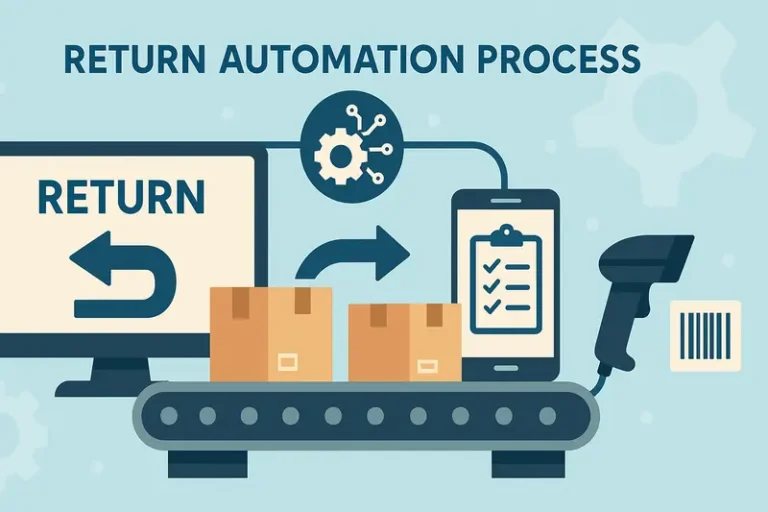Returns Automation: AI and Improving Efficiency & Profits in Ecommerce

Last updated on April 29, 2025

In this article
 11 minutes
11 minutes
- Introduction to Ecommerce Returns
- The Growing Need for Returns Automation
- How AI and Automation Improve the Returns Process
- Key Features of Ecommerce Returns Automation
- The Role of AI in Managing Returns Data and Improving Profitability
- Ecommerce Returns and Business Operations
- Automating Returns: The Key to Increased Efficiency and Customer Loyalty
- Best Practices for Ecommerce Returns
- Future of Ecommerce Returns
- Summary
- Frequently Asked Questions
Ecommerce businesses have always faced the challenge of managing returns efficiently. As online shopping continues to grow, returns have become an unavoidable reality for many retailers. However, the process of handling these returns doesn’t have to be a burden. In fact, with the integration of AI and automation, including automated returns, ecommerce businesses can streamline the returns process, enhance customer satisfaction, and even boost profits.
In this article, we’ll explore how AI-powered returns automation systems are transforming the returns management process, enabling ecommerce businesses to improve operational efficiency, reduce costs, and create a seamless experience for customers. We’ll also highlight the role of returns automation systems in gaining a competitive advantage and driving customer loyalty.
Introduction to Ecommerce Returns
Ecommerce returns are an inevitable part of any online business, with the average rate of ecommerce customer returns ranging from 20-30%. The returns process can be a complex and time-consuming aspect of ecommerce operations, but it also presents an opportunity to build customer loyalty and improve customer satisfaction. By implementing an efficient returns process, ecommerce businesses can reduce costs, increase customer lifetime value, and gain a competitive advantage in the market. In this guide, we will explore the importance of ecommerce returns, the benefits of automating the returns process, and the key features of ecommerce returns automation.
Make Returns Profitable, Yes!
Cut shipping and processing costs by 70% with our patented peer-to-peer returns solution. 4x faster than traditional returns.
See How It WorksThe Growing Need for Returns Automation
The Impact of High Return Rates on Ecommerce Businesses
Returns are a significant challenge for ecommerce retailers. According to the National Retail Federation, the average ecommerce return rate can be as high as 20-30%, depending on the product category, with fashion and electronics facing the highest return rates. The returns process can be time-consuming, resource-intensive, and costly, especially when businesses rely on manual processes to manage customer returns.
The impact of returns doesn’t stop at operational inefficiency. The costs associated with processing returns (including return shipping costs, inventory management, and restocking fees) can eat into profit margins. Additionally, if returns are handled poorly or slowly, it can damage customer satisfaction and hurt customer loyalty. This, in turn, affects customer lifetime value and the likelihood of repeat purchases, particularly for online purchases.
The need for returns automation becomes clear. By automating various aspects of the returns management process, businesses can reduce human error, increase efficiency, and deliver a smoother, faster returns experience that keeps customers happy and coming back for more.
How AI and Automation Improve the Returns Process
1. Automating the Entire Returns Process
A major advantage of returns automation is the ability to streamline and simplify the entire returns journey, from return request online to refund processing. AI-powered returns management software can handle tasks such as generating return labels, approving returns based on predefined automation rules, and updating customers in real time about the status of their returns. This automation system takes over repetitive manual tasks, allowing customer service teams to focus on more complex issues and freeing up time for other important tasks.
- Return requests online can be submitted through a customizable return portal, where customers select items, indicate the reason for return, and choose whether to exchange or return the item for a refund. A centralized portal can further streamline the returns process by allowing users to manage carrier accounts, return locations, and generate return labels efficiently.
- AI and automation rules help verify if the item qualifies for a return, based on the company’s return policy and product condition, all without requiring human intervention.
By automating these routine tasks, businesses can reduce the time spent processing returns, improving operational efficiency, and decreasing operational costs.
2. Reducing Costs Through Efficient Returns Management
One of the key benefits of returns automation is the potential for reduced costs. Automated systems can process returns management more efficiently, reducing labor costs and errors. For example, by automating the generation of return labels and return shipping labels, businesses can avoid the logistical complexity of manually generating labels for each return request. This improves inventory management, reduces unnecessary shipping costs, and accelerates the reverse logistics process.
Additionally, automated status updates can keep customers informed throughout the return process, from the moment they initiate a return to when they receive their refund or store credit. This reduces customer inquiries, freeing up customer support teams to handle more complex issues.
3. Enhancing Customer Experience and Loyalty
The returns experience has a significant impact on customer experience and customer loyalty. A seamless, efficient returns process can enhance customer satisfaction, increase the likelihood of repeat purchases, and boost customer retention.
By automating the returns process, businesses can offer faster processing times, ensuring that customers receive timely refunds or store credit. Customers who are given store credit instead of a full refund can be encouraged to make future purchases, while also preventing revenue loss from returns.
Additionally, offering a self-service platform for returns where customers can manage their return requests, print prepaid return labels, and track the status of their returns allows customers to feel in control of the situation. This self-service return portal helps foster a positive post-purchase experience, which is crucial in maintaining customer loyalty.
Key Features of Ecommerce Returns Automation
Ecommerce returns automation is a game-changer for online businesses, enabling them to streamline their returns process, reduce manual labor, and improve customer satisfaction. The key features of ecommerce returns automation include automatic label generation, customizable return portals, real-time tracking updates, and return automation rules. These features enable customers to initiate returns online, print pre-paid return labels, and track the status of their returns in real-time. By automating the returns process, ecommerce businesses can increase efficiency, reduce costs, and provide a better customer experience.
Convert Returns Into New Sales and Profits
Our peer-to-peer returns system instantly resells returned items—no warehouse processing, and get paid before you refund.
I'm Interested in Peer-to-Peer ReturnsThe Role of AI in Managing Returns Data and Improving Profitability
1. Gathering and Analyzing Valuable Return Data
AI and machine learning can provide ecommerce businesses with valuable insights into why products are being returned. By analyzing valuable data, such as the frequency of returns, the most common reasons for returns, and trends in specific product categories, businesses can identify patterns and optimize their product catalog.
For example, if a particular product receives a high number of returns due to size issues, the business can improve its product descriptions and size guides to reduce returns in the future. Additionally, AI tools can provide insights into which products are most likely to be returned, allowing businesses to adjust their marketing or sales strategies accordingly.
2. Predicting and Preventing Future Returns
AI and automation don’t just help with current returns management, they can also help predict future returns. By using predictive analytics, historical return data, and various key metrics such as return rates, return reasons, return costs, return times, and customer satisfaction, AI systems can flag products that are more likely to be returned before the purchase is even made. This enables businesses to proactively adjust their return policies or recommend more suitable products to customers, reducing future returns.
For example, a recommendation system powered by AI can suggest alternative products to customers that may have a lower likelihood of being returned. This reduces return rates and improves customer experience by offering them exactly what they need.
Ecommerce Returns and Business Operations
Ecommerce returns have a significant impact on business operations, from inventory management to customer service. By implementing an efficient returns process, ecommerce businesses can reduce the risk of lost revenue, improve operational efficiency, and build customer loyalty. A well-managed returns process can also provide valuable insights into customer behavior, helping businesses to identify areas for improvement and optimize their operations. Additionally, ecommerce returns automation can help businesses to stay ahead of the competition, particularly during peak periods such as the holiday season.
Automating Returns: The Key to Increased Efficiency and Customer Loyalty
1. Implementing an Efficient Return Process
For businesses looking to implement returns automation, the first step is to choose the right returns management software. A returns management system (RMS) should integrate with your ecommerce platform, inventory management systems, warehouse management systems, and customer service platforms. This ensures that returns data is collected in real-time and processed efficiently.
Key features to look for when selecting returns management software:
- Automated return labels generation
- Integration with inventory systems for real-time stock updates
- Ability to handle international returns seamlessly
- Customizable return portal for customers
- Automated status updates for customers, reducing inquiries
By selecting the right software and automating the returns process, businesses can significantly improve operational efficiency, reduce costs, and boost customer satisfaction.
2. Implementing Return Automation Rules for a Competitive Advantage
Implementing returns automation rules is crucial for improving customer service while minimizing return shipping costs and operational costs. Integrating with helpdesk software, along with other business tools, can enhance the returns process by improving accuracy and customer satisfaction. AI-driven rules can automatically approve returns based on a product’s condition, the reason for the return, and whether it meets the company’s return policy criteria.
For example, AI automation systems can flag high-risk returns and ensure that only eligible returns are processed, reducing return fraud. Automated systems can also provide customers with immediate refunds or store credits once a return has been approved, improving the post-purchase experience and ensuring that customers feel valued.
By leveraging automation and AI, businesses can gain a competitive advantage by delivering a smoother, faster returns process, ultimately enhancing customer loyalty and increasing customer lifetime value.
Best Practices for Ecommerce Returns
To implement an effective ecommerce returns strategy, businesses should follow best practices such as providing clear return policies, offering pre-paid return labels, and using automation systems to streamline the returns process. It’s also essential to have a customer service team in place to handle routine tasks and provide support to customers. By implementing these best practices, ecommerce businesses can improve customer satisfaction, reduce costs, and increase customer lifetime value. Furthermore, businesses should regularly review their returns management process to identify areas for improvement and optimize their operations.
No More Return Waste
Help the planet and your profits—our award-winning returns tech reduces landfill waste and recycles value. Real savings, No greenwashing!
Learn About Sustainable ReturnsFuture of Ecommerce Returns
The future of ecommerce returns is likely to be shaped by technological advancements, changing customer expectations, and the growing importance of sustainability. As ecommerce businesses continue to evolve, they will need to adapt their returns strategies to meet the changing needs of their customers. This may involve implementing new technologies, such as artificial intelligence and machine learning, to streamline the returns process and improve customer satisfaction. Additionally, businesses will need to prioritize sustainability, reducing waste, and minimizing the environmental impact of their returns operations. By staying ahead of the curve, ecommerce businesses can build a competitive advantage, improve customer satisfaction, and drive long-term growth.
Summary
AI and automation are transforming the way ecommerce businesses handle returns, from automating the returns process to reducing return shipping costs and improving operational efficiency. By investing in returns management systems, leveraging AI-driven data analytics, and implementing automated return rules, businesses can boost customer satisfaction, reduce costs, and improve profit margins. The seamless returns process created through automation not only saves time and reduces the risk of human error but also plays a crucial role in building customer loyalty and increasing repeat purchases.
As the ecommerce landscape evolves, integrating automation and AI into returns management will be a key factor in maintaining a competitive advantage and ensuring long-term business success.
Frequently Asked Questions
How does AI improve the returns process in ecommerce?
AI improves the returns process by automating key tasks such as return approvals, label generation, and status updates. It also helps with fraud detection and provides personalized return options to enhance the customer experience.
How does automation help reduce return shipping costs?
Automation optimizes the reverse logistics process by automatically generating return labels and choosing the most cost-effective shipping routes. It also helps reduce operational inefficiencies, leading to overall cost savings in the returns process.
Can AI predict future returns?
Yes, AI can analyze historical return data to identify patterns and predict which products are more likely to be returned, allowing businesses to proactively adjust their inventory management, marketing, and sales strategies.
What are the main benefits of returns automation for ecommerce businesses?
The main benefits include improved efficiency, reduced shipping costs, enhanced customer satisfaction, and the ability to offer a seamless returns process that builds customer loyalty and increases revenue.
How can AI and automation improve customer loyalty?
By automating the returns process and offering personalized return options, AI and automation ensure a faster, smoother experience for customers. This not only reduces customer frustration but also improves customer retention, leading to higher customer lifetime value.

Turn Returns Into New Revenue





